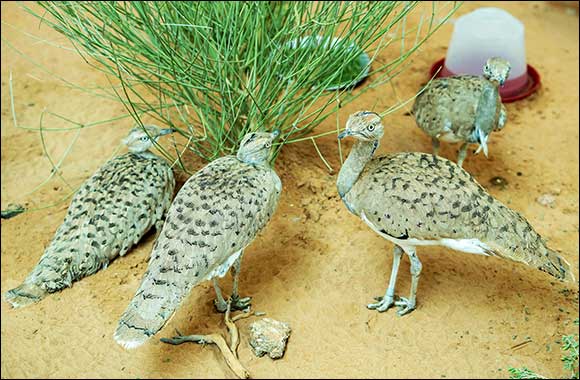
Half a Million Birds Released to Boost the Sustainability of Houbara Populations in the Wild
International Fund for Houbara Conservation Continues its Cultural and Scientific Programs at ADIHEX 2024
Abu Dhabi – 05 September 2024: The International Fund for Houbara Conservation (IFHC), the global leader in pre-emptive species conservation, has announced a total production of 888,256 houbara bustards at its breeding and research centres in Abu Dhabi, Morocco, and Kazakhstan since the inception of its conservation programmes. Under the leadership and guidance of His Highness Sheikh Mohamed bin Zayed Al Nahyan, President of the UAE and Ruler of Abu Dhabi, IFHC has effectively preserved and released 534,122 birds to rebalance wild houbara populations across their international range of distribution in Asia and North Africa.
Commenting on IFHC's outstanding participation in the Abu Dhabi International Hunting and Equestrian Exhibition (ADIHEX) 2024, His Excellency Abdulla Ghurair Al Qubaisi, Director General of the International Fund for Houbara Conservation, said: “Our success is inspired by the directives of His Highness Sheikh Mohamed bin Zayed Al Nahyan, President of the UAE and Ruler of Abu Dhabi, to preserve our environmental and cultural heritage for future generations.
This commitment reflects the vision of our Father of the Nation, the late Sheikh Zayed bin Sultan Al Nahyan, who recognised the decline of houbara populations and established the Abu Dhabi Houbara Conservation Programme. This program employs a holistic global approach that combines captive breeding and habitat protection.”
Over the five decades, the conservation program has built a comprehensive understanding of the houbara. This includes its ecology, genetics, ecological behaviour, distribution, breeding areas, and migration routes. We have also developed standard techniques and protocols for captive breeding using artificial insemination and incubation, and the propagation of breeding birds separately from release birds to boost wild populations.
The success story of the houbara is part of a broader narrative of successful conservation efforts in Abu Dhabi, which has managed to protect and restore various threatened species in the desert habitat, including the oryx, Arabian tahr, dugongs, and sea turtles. “The houbara conservation initiative is a key indicator of the protection of an integrated ecosystem in the desert and remote areas, where local communities, with their rich and ancient cultures and traditions, play a crucial role,” His Excellency Abdulla Ghurair Al Qubaisi explained.
IFHC operates one of the largest conservation programmes globally, building on a legacy that stretches back nearly 50 years, beginning with Al Ain Zoo's initial efforts in houbara captive breeding and propagation to preserve their populations in the wild in 1977.
In 1982, the program achieved a milestone by breeding the first Asian houbara chick at Al Ain Zoo. This was followed by the establishment of the National Avian Research Center (NARC) in 1989 as the first specialised facility for captive breeding and scientific research on the Asian houbara. This progress continued with the inauguration of the Emirates Center for Wildlife Propagation (ECWP) in Missour, Morocco, a major centre for the captive breeding and propagation of North African houbara bustards.
Whereas, the Sheikh Khalifa Houbara Breeding Centres in Abu Dhabi and Kazakhstan have further contributed to the upward trend in houbara produced and released in the UAE and other distribution countries. Significant advances have also been made in houbara propagation, enhancing their survival rates in nature, alleviating pressure on wild populations, and ensuring their protection in collaboration with deploying countries.
The houbara conservation programme has succeeded in preserving houbara through protection, sustainable management, captive breeding, and release into the wild. It draws on a scientific base derived from research, field studies, and technical development of methods for raising birds in captivity, preparing them for release, and conducting post-release monitoring. Additionally, IFHC has expanded international partnerships and focused on socio-economic development in houbara habitats.
ShareHome >> Local News and Government Section
Emirates Aviation University marks 35 years of supporting the local and global aviation ecosystem
Music, Maps, and Stories at the Mohammed Bin Rashid Library in July
New SHEGLAM Daydreamer Mini Palette Turns Pocket-Sized into Power Pigment
Passenger Growth Hits 5% in May
João Almeida: Racing for Glory and Riding for the Team
May Air Cargo Demand Up 2.2% Despite Trade Disruptions
Return to Ritual: Celebrate Self-Care Month with BUFARMA Skincare
Rediscover family shopping days: REDTAG opens its doors in Al Ain
Dubai Culture Launches Open Call for 14th Sikka Art & Design Festival
Summer Restaurant Week Returns This DSS with Over 65 Exclusive Dining Deals Across Dubai
Julien Calloud Appointed CEO of SAVOYE to Lead a New Era of Performance and Innovation
Zoho Powers Up CRM for Everyone Platform with AI to Elevate Customer Experience
Media's Role in the Age of Algorithms By HH Sheikha Latifa bint Mohammed bin Rashid Al Maktoum
